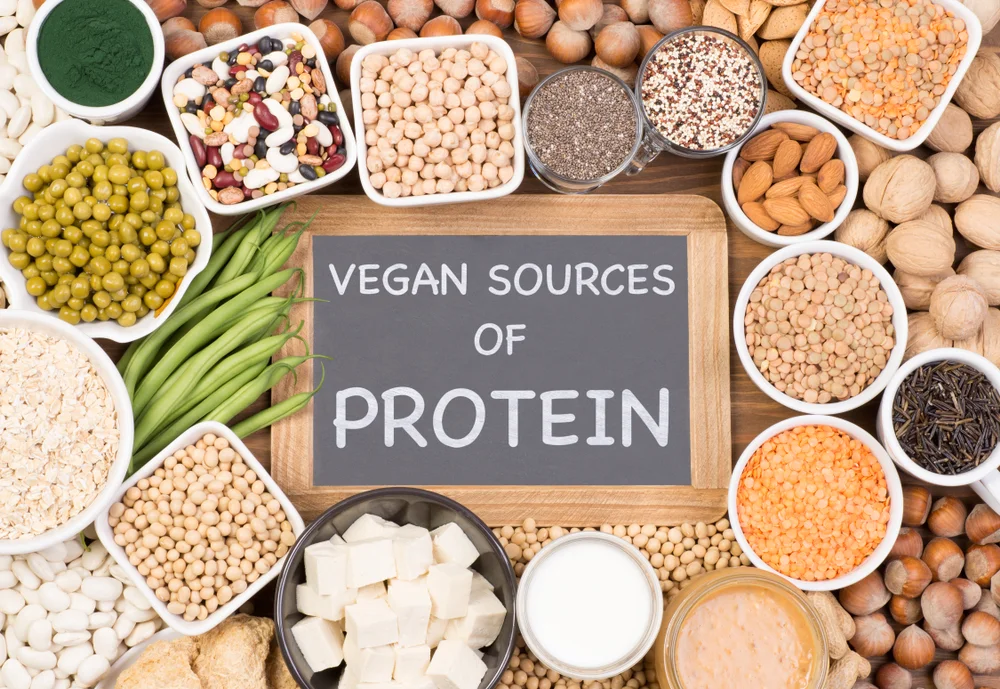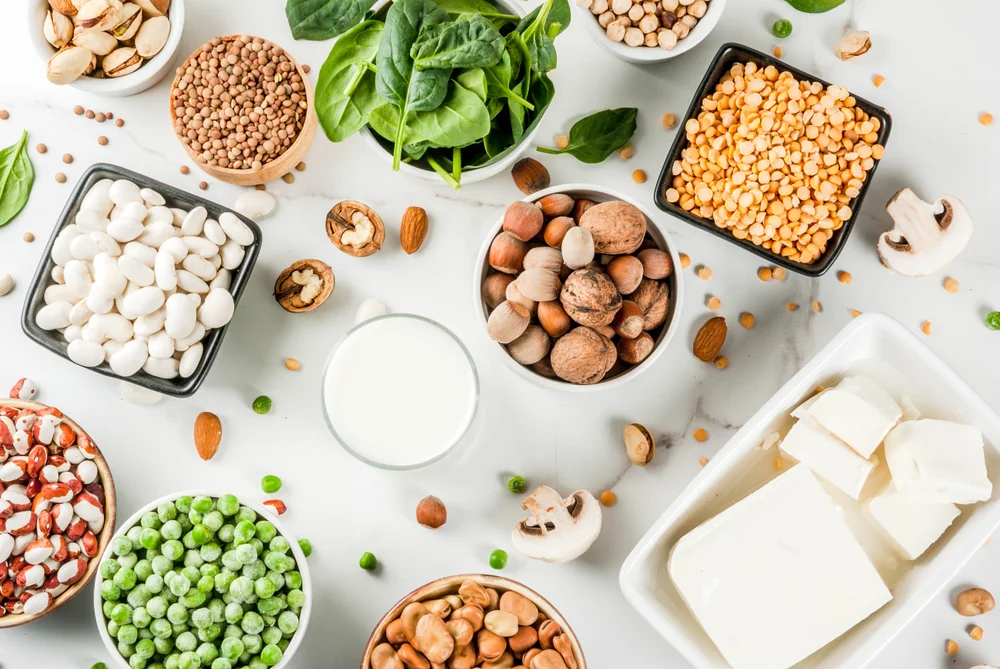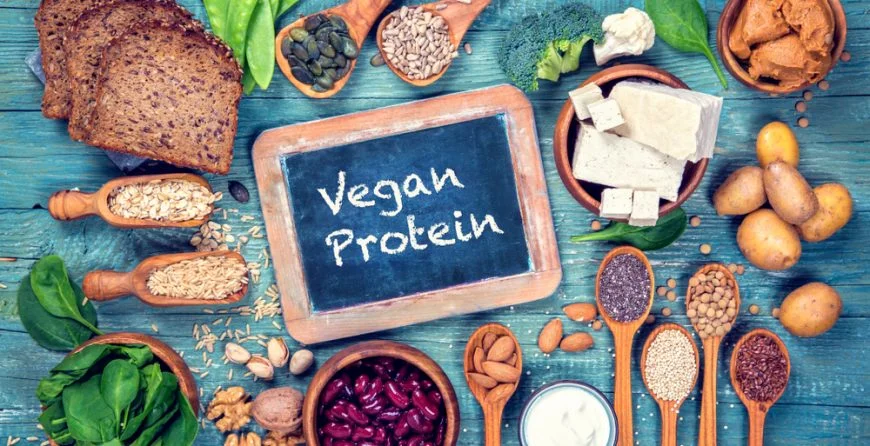When evaluating vegetarian-based protein sources, it’s essential to consider their nutritional content, including protein quality, digestibility, and additional nutrients. Here’s a breakdown of the best, worst, and everything in between:

The Best Vegetarian-Based Protein Sources:
- Legumes (Beans, Lentils, Chickpeas)
- Soy Products
- Quinoa
- Nuts and Seeds
- Whole Grains
- Seitan
- The Worst Vegetarian-Based Protein Sources (in terms of protein content)
- Fruits
- Starchy Vegetables
- Processed Meat Alternatives
Outline
The best vegetarian-based protein sources are those that provide a complete amino acid profile, are nutrient-dense and contribute to overall health. Intermediate sources can still be valuable parts of a balanced diet, especially when combined with other protein sources to ensure a complete amino acid intake. The worst sources, while they may still have nutritional value in other areas, should not be relied upon as primary protein sources due to their lower protein content or potential health concerns related to processing.
How plant-based proteins compare
| Plant-based protein | Serving size | Calories | Protein | Fat | Carbohydrates | Fiber | Sodium |
| Pea protein powder | 1 scoop (22 g) | 100 | 19 g | 2 g | 1 g | 0 g | 260 mg |
| Quinoa (cooked) | 1 c. | 222 | 8.1 g | 3.5 g | 39.4 g | 5.1 g | 13 mg |
| Chickpeas, canned, low sodium | ½ c. | 105 | 6 g | 2.3 g | 16.2 g | 5.3 g | 158 mg |
| Black beans, canned, without salt | ½ c. | 114 | 7.5 g | 0.5 g | 20 g | 15 g | 0.5 mg |
| Vital wheat gluten (seitan) | ¼ c. | 104 | 21 g | 0.5 g | 4 g | 0.2 g | 10 mg |
| Tofu (extra-firm) | 3.5 oz. | 94 | 10.6 g | 4.7 g | 3.5 g | 1.2 g | 18 mg |
| Lentils | ½ c. | 115 | 9 g | 0.4 g | 20 g | 8 g | 2 mg |
| Oats | ½ c. | 153 | 5.3 g | 2.5 g | 25 g | 4 g | 3 mg |
| Peanut butter (smooth, no salt) | 2 Tbsp. | 191 | 7.1 g | 16.4 g | 7.1 g | 1.4 g | 5 mg |
| Edamame | ½ c. | 94 | 9.2 g | 4 g | 7 g | 4 g | 4 mg |
The science behind vegetarian-based protein
The science behind vegetarian-based protein involves understanding the nutritional composition, bioavailability, and health benefits of plant-derived protein sources. Here are the key scientific aspects (1) :
Protein Composition
Amino Acids: Proteins are made up of amino acids, including essential amino acids that the body cannot synthesize and must be obtained from the diet.
Complete Proteins: Foods that contain all nine essential amino acids in adequate proportions. Examples include quinoa, soy products (tofu, tempeh), and certain combinations like rice and beans.
Most plant proteins fall into this category but can be combined to form a complete amino acid profile (e.g., legumes with grains). (2)
Protein Quality and Digestibility
Protein Digestibility-Corrected Amino Acid Score (PDCAAS):
A measure of protein quality based on the amino acid requirements of humans and their ability to digest it. Animal proteins typically have higher PDCAAS scores, but some plant proteins like soy also score high. (3)

Digestibility: Plant proteins often have lower digestibility compared to animal proteins due to the presence of anti-nutritional factors like phytates and tannins. However, cooking and processing methods can improve digestibility. (4)
Health Benefits:
Cardiovascular Health: Plant-based proteins are generally lower in saturated fats and cholesterol. Diets high in plant-based proteins have been associated with reduced risks of heart disease. (5)
Weight Management: Plant-based proteins are often high in fiber, which promotes satiety and helps with weight management.
Diabetes Management: Plant-based diets can improve blood sugar control and insulin sensitivity. (6)
Common Vegetarian-Based Protein Sources:
Legumes: High in protein and fiber and can be combined with grains to form complete proteins.
Whole Grains: Such as quinoa, brown rice, and oats, which provide protein as well as important vitamins and minerals.
Vegetables: While generally lower in protein, some vegetables like broccoli, spinach, and Brussels sprouts contribute to overall protein intake.
Challenges and Solutions:
Meeting Protein Needs: Careful planning is required to ensure sufficient intake of all essential amino acids.
Anti-Nutritional Factors: These can be reduced through methods like soaking, fermenting, and cooking.
Intermediate Vegetarian-Based Protein Sources:
Vegetables:
Moderate protein content, but high in vitamins, minerals, and antioxidants.
Examples: Broccoli, spinach, Brussels sprouts.
Dairy Products:
best sources of protein, calcium, and vitamin D.
Examples: Greek yogurt, cottage cheese, milk.
Plant-Based Protein Powders:
Convenient and concentrated sources of protein.
Examples: Pea protein, rice protein, hemp protein.
The Worst Vegetarian-Based Protein Sources:
Fruits
Generally low in protein but high in vitamins, minerals, and fiber.
Examples: Apples, oranges, berries.
Starchy Vegetables:
Lower protein content but provides carbohydrates and other nutrients.
Examples: Potatoes, corn, squash.
Processed Meat Alternatives:
Often high in sodium, preservatives, and other additives.
Examples: Veggie burgers, and imitation sausages. (7)
Outline
The science behind vegetarian-based protein highlights its nutritional adequacy, health benefits, and environmental advantages. While there are challenges in terms of amino acid completeness and digestibility, these can be managed through dietary planning and food preparation techniques. (8)
Soy side effects?
While soy is a highly nutritious and versatile protein source, it can have some side effects and concerns for certain individuals.
- Soy is one of the common allergens, especially in children. – Some people may experience gastrointestinal discomfort such as bloating, gas, and diarrhea due to the oligosaccharides in soy, which can be difficult to digest.
- Soy contains goitrogens, which can interfere with thyroid hormone synthesis and potentially affect thyroid function, especially in individuals with pre-existing thyroid conditions.
- Soy contains phytoestrogens (isoflavones), which are plant compounds that mimic estrogen.
The environmental benefits of vegetarian-based protein
The environmental benefits of vegetarian-based protein are significant, here are some keys
Lower Greenhouse Gas Emissions
- Plant-based proteins generally produce far fewer greenhouse gases (GHGs) than animal proteins.
- Producing plant-based proteins requires less energy than raising animals, reducing overall carbon emissions.
Reduced Land Use
- Growing plants for direct human consumption requires less land compared to growing feed crops for livestock.
- Lower demand for animal products can reduce deforestation, which is often driven by the need for grazing land and feed crop cultivation.
Lower Water Usage
Plant-based protein production generally requires significantly less water than animal agriculture. For example, producing a pound of beef can require thousands of gallons of water.
Less Pollution
- Animal farming is a major source of water pollution due to runoff from manure and feedlots, which can contaminate water bodies with nutrients, antibiotics, and hormones.
- Livestock operations can contribute to air pollution through the release of ammonia and other pollutants.
Soil Health
Livestock farming can lead to soil degradation through overgrazing, compaction, and erosion. Plant-based farming, especially when employing sustainable practices like crop rotation and cover cropping, can enhance soil health and fertility.
Frequently asked questions
Have more questions about vegetarian-based protein? Get the facts below:
What “are the best plant-based protein sources”?
The best plant-based protein sources include a variety of legumes, grains, nuts, seeds, and other plant-derived foods.
Versatile and nutrient-dense, chickpeas are great in salads, stews, and as a base for hummus.
Packed with protein, fiber, and antioxidants, they are excellent in various dishes.
A highly versatile protein source made from soybeans, great for stir-fries, soups, and salads.
Fermented soybeans provide more protein and a firmer texture than tofu.
Young soybeans are often enjoyed as a snack or in salads and bowls
A complete protein containing all nine essential amino acids, also high in fiber and minerals.
High in protein, omega-3 fatty acids, and fiber; can be added to smoothies, yogurt, and baked goods.
Contain complete protein and are rich in healthy fats; can be sprinkled on salads and cereals.
High in protein, healthy fats, and vitamin E; great as a snack or in almond butter form.
Broccoli: Contains a good amount of protein relative to other vegetables, along with fiber and vitamins.
Spinach: Rich in protein, iron, and various vitamins; great in salads, smoothies, and cooked dishes.
Nutritional yeast: A deactivated yeast that is high in protein and B vitamins, often used as a cheese substitute. (9)
Who shouldn’t eat vegetarian-based protein?
Vegetarian-based protein sources are generally safe and healthy for most people, but certain individuals might need to be cautious or avoid some vegetarian protein sources due to specific health conditions, allergies, or dietary needs. Here are some groups who might need to avoid or be cautious with vegetarian-based protein sources
- People with Allergies
- Individuals with Certain Medical Conditions
- People Following Specific Diets
- Individuals with Digestive Issues
- Infants and Young Children
- People with Histamine Intolerance
As with any dietary considerations, individuals with specific health conditions or dietary restrictions should consult with a healthcare professional or registered dietitian.
How does vegetarian-based protein powder compare to whey powder?
Both vegetarian-based and whey protein powders can be effective for meeting protein needs, but the best choice depends on individual dietary preferences, health considerations, and ethical beliefs. Whey protein is typically superior in terms of protein content and digestibility for those who are not lactose intolerant or allergic to dairy. On the other hand, vegetarian protein powders offer a more environmentally friendly and ethically aligned option for those who avoid animal products or have dairy sensitivities.
What’s the best-tasting vegetarian-based protein powder?
The best-tasting vegetarian-based protein powder can vary depending on individual taste preferences and dietary restrictions. some brands and flavors are consistently well-regarded for their taste and texture. few popular options:
- Orgain Organic Protein Powder
- Vega Protein & Greens
- Garden of Life Organic Plant-Based Protein
- Sun Warrior Blend
When choosing a vegetarian-based protein powder, it’s essential to consider factors like taste, texture, nutritional content, and any dietary restrictions or allergies you may have.
Where can I find vegetarian-based protein recipes?
You can find vegetarian-based protein recipes in a variety of places, including cookbooks, websites, blogs, and social media platforms.
Look for vegetarian or plant-based cookbooks that focus on incorporating protein-rich ingredients like legumes, tofu, tempeh, seitan, quinoa, and nuts into meals.
Look for vegetarian or plant-based cookbooks that focus on incorporating protein-rich ingredients like legumes, tofu, tempeh, seitan, quinoa, and nuts into meals.
Specific vegetarian recipe apps like Forks Over Knives, Oh She Glows, and Veganized cater to those following plant-based diets and often include protein-rich recipes.
Takeaway
Legumes, grains, nuts, seeds, soy products, and vegetables are excellent sources of plant-based protein.
While plant-based proteins are generally healthy, for individuals with allergies, and specific medical conditions.
Vegetarian-based protein powders offer comparable protein content, but whey protein is generally more quickly absorbed and has a complete amino acid profile.
Look for vegetarian-based protein recipes in cookbooks, websites, blogs, recipe apps, social media platforms, and YouTube channels dedicated to vegetarian and plant-based cooking.




